On Site with U.S. Gold Corp at the Wyoming CK Gold Project
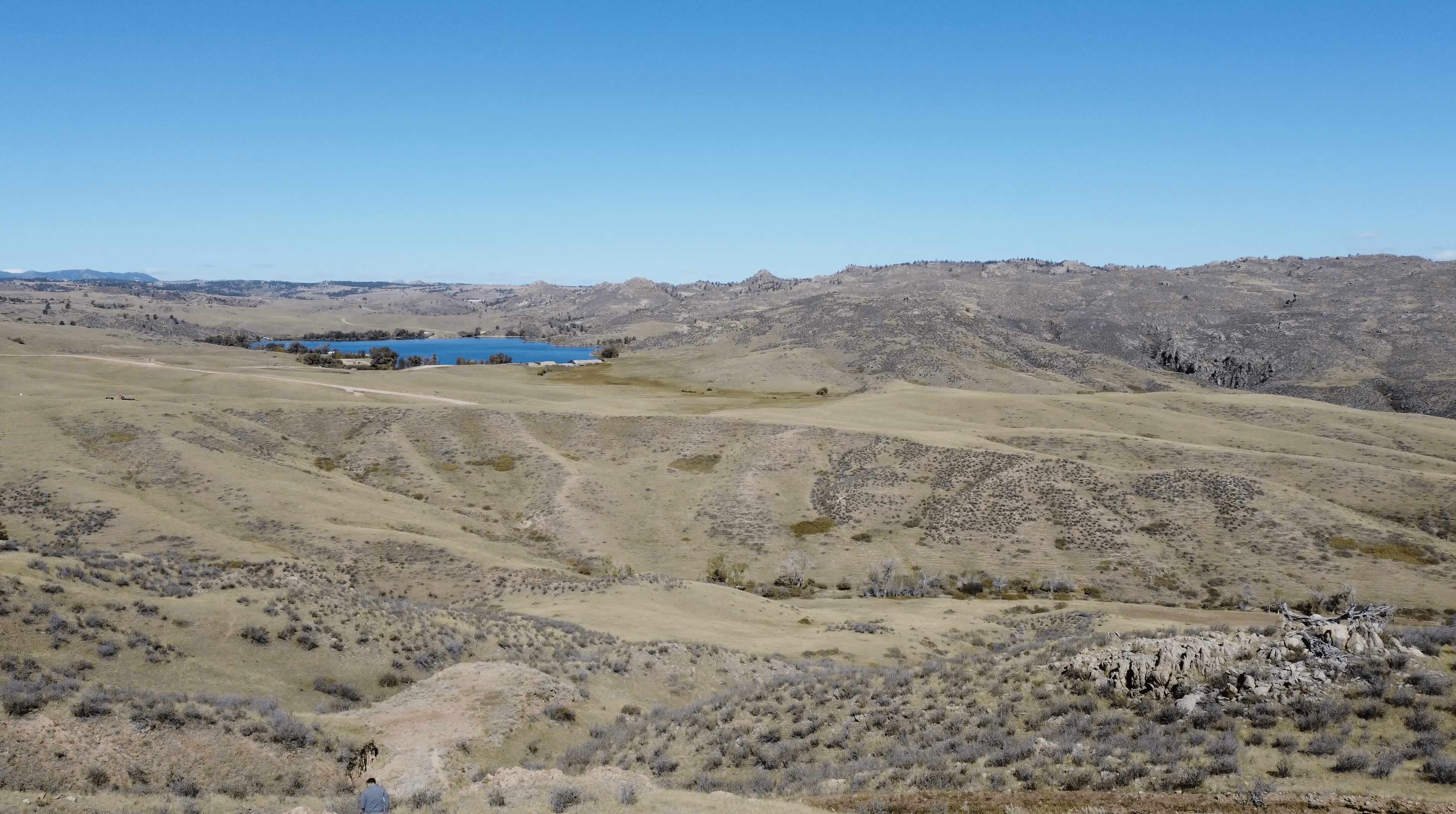
US Gold Corp's fully permitted CK Gold Project targets 110k oz/year gold production at $940/oz costs, 20 miles from Cheyenne. Construction starts 2026.
- US Gold Corp is developing a fully permitted, shovel-ready gold-copper project just 20 miles from Cheyenne, Wyoming, with exceptional proximity to existing infrastructure including power, rail, and workforce
- The CK Gold Project contains 1.7 million ounces of gold equivalent reserves with targeted annual production of 110,000 ounces over a 10-year mine life at an all-in sustaining cost of $940 per ounce
- Wyoming's first hard rock mining permit in 100 years was achieved with minimal public opposition due to the project's simple processing method (no leaching or tailings dam) and strong community engagement
- The company is led by veteran mine builder George Bee (CEO), who built Barrick's Goldstrike, and has secured key infrastructure including 7.2 cents/kWh power pricing and is advancing towards construction in early 2026
- Additional revenue streams from aggregate sales could add $10-15 million annually to an already robust economic profile showing sub-one-year payback at current gold prices
Pioneering Wyoming's Hard Rock Mining
US Gold Corp is breathing new life into Wyoming's historic Silver Crown Mining District, developing what will become the state's first hard rock mine in a century. The CK Gold Project, situated just 20 miles west of Cheyenne, represents a compelling convergence of modern mining technology, exceptional infrastructure access, and a resource base that has captured attention from both investors and industrial partners. With full permits in hand and construction set to begin in early 2026, the company stands at the threshold of transforming a historic copper-gold district into a modern mining operation that could generate significant returns in today's elevated precious metals environment.
During a recent site visit to the project, the advantages that set CK Gold apart from typical North American mining developments became immediately apparent. Standing atop the future open pit location, the proximity to critical infrastructure is striking - wind turbines connected to the power grid are visible to the southeast, the Union Pacific rail line runs just four miles away, and the lights of Cheyenne glimmer on the eastern horizon.
"You can grab a cup of coffee, get out to the site, and coffee's still warm," Jason Beggar notes from the project's vantage point, emphasizing the remarkable accessibility that distinguishes CK Gold from remote mining projects that require extensive logistics and infrastructure development.
Interview with Executive Chairman, Luke Norman
A Project Built on Location Advantage
Luke Norman, Executive Chairman of US Gold Corp, emphasizes what he sees as the project's defining characteristic:
"The biggest standout about this project and about this company is exactly that - the location. The old adage that's used by realtors: location, location, location. A deposit like this being 20 miles outside of a major resource hub... it's an hour and a half drive north of Denver, Colorado. It's right on the I-80 corridor with major rail, road, power networks all rolling through it."
This proximity advantage translates directly into economics that differentiate CK Gold from more remote mining projects. George Bee, the company's CEO and a veteran mine builder who cut his teeth constructing Barrick's Goldstrike operation, provides context while showing core samples at the project's facility: "All ounces aren't created equal. If you're up in the Andes... we had about a two gram per ton average gold grade. But we had to build 170 miles of road from the provincial roads up into the Andes Mountains across big high passes. We had to build a 3,500 person man camp... and put in 20 megawatts of power generation."
In contrast, at CK Gold, Bee explains:
"At the CK Gold project, with half a gram of gold, with the local power supply, with the road network already here, and the people that we can employ from the local community, we don't have to have all of the logistics and construction in order to be able to support the operation."
The company recently secured a power agreement with Black Hills Energy at 7.2 cents per kilowatt hour, with power lines running directly to the project site - a stark contrast to operations that must construct hundreds of kilometers of transmission infrastructure.
Understanding the Resource: From Historic High-Grade to Modern Bulk Mining
The CK Gold deposit sits within the historic Silver Crown Mining District, where miners in the late 1800s and early 1900s extracted high-grade copper and gold from underground workings. Walking across the project site with George Bee, evidence of this historic activity is everywhere – from green copper oxide staining on surface rocks to the reclaimed shaft locations that dot the landscape.

"When the railroad came through, obviously people were looking in the area and they found copper staining," Bee explains, picking up a piece of mineralized rock showing chrysocolla and other copper minerals. "In the old times, in the 1920s, they essentially made a shaft, had some lateral development and they were following some of the really high grade copper. But now what we're chasing is the rest of the copper and gold in a big halo around here."
The historic context provides important perspective on the district's potential. Bee elaborates while standing near a reclaimed shaft: "There was a little town of Hecla with about 800 people in the late 1800s, part of the last century, mining high grade here." The remnants of this mining heritage are still visible with stone foundations of a stamp mill sitting above nearby farm buildings, silent testimony to the area's rich mining past. "Come the 1920s, copper was 15 to 20 cents a pound and gold was fixed at $37 per ounce. It essentially just got to the point where there wasn't high grade to sustain continued operations."
The Technical Foundation: Geology & Mineralization
The transition from historic selective underground mining to modern bulk extraction represents a fundamental shift in approach. In the core shack, Bee demonstrates the difference between the high-grade material that attracted historic miners with samples showing visible chalcopyrite with grades of 8% copper and 12 grams per tonne gold, and the disseminated mineralization that comprises the bulk of today's resource.
"If it was all like this, it would have been gone a long time ago," Bee notes, handling the high-grade specimen before turning to more typical ore samples. "The mineralization is disseminated so that's why we've got to crush it all up and extract a concentrate which we can sell."
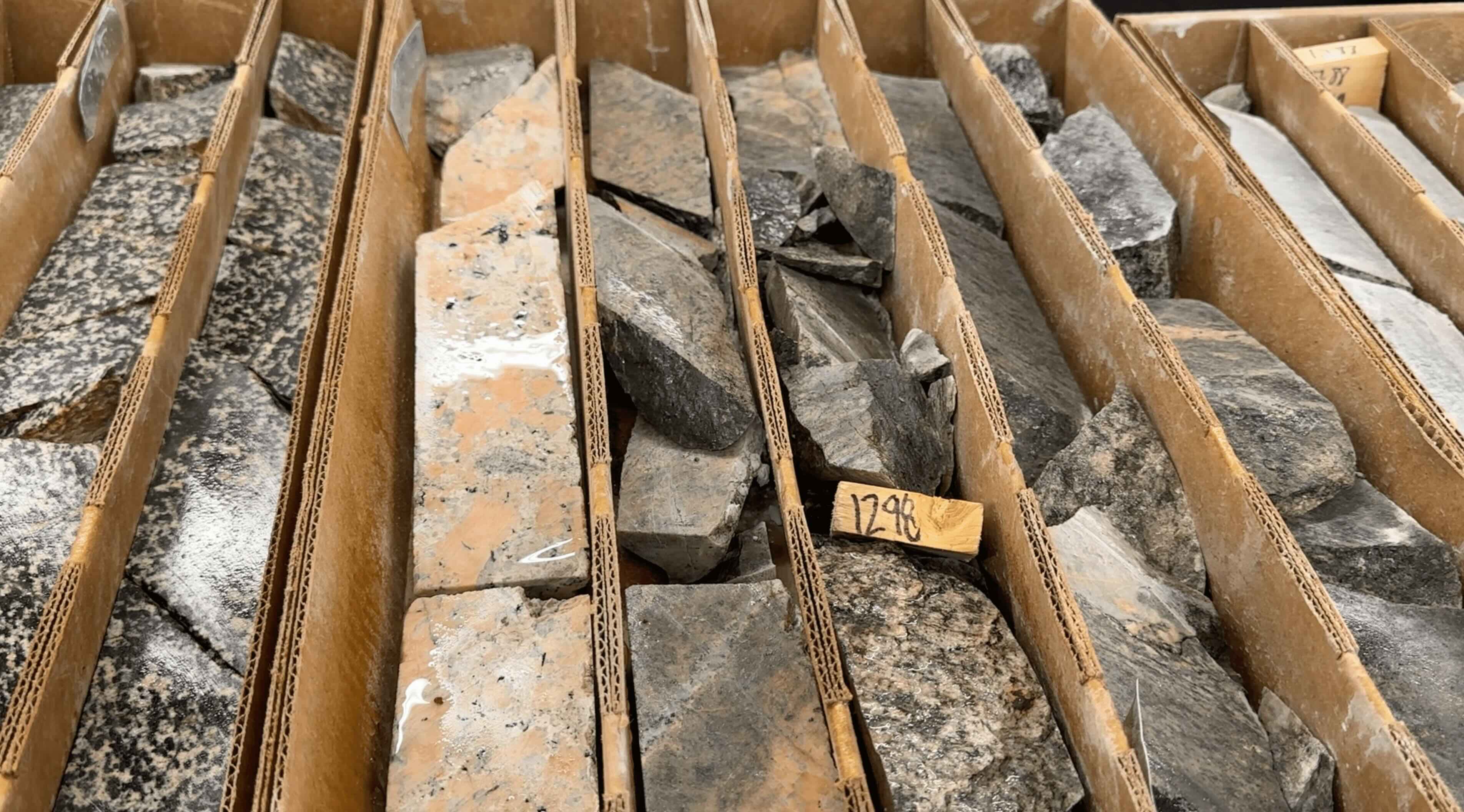
The current resource averages 0.5 grams per tonne gold and 0.17% copper – grades that would have been uneconomic in the 1920s but generate robust margins with modern processing technology. When asked about the copper-to-gold ratio, Bee provides technical detail:
"Our average grade is about 0.5 grams per tonne gold, which is 0.5 ppm, whereas the copper is about 0.2 percent by weight. So there's about 35 times more copper content than gold."
The deposit's geology reveals itself through three distinct alteration types within the 1.6-billion-year-old granodiorite host rock. Bee shows samples of each: fresh granite that looks "like a granite kitchen countertop," potassium-altered rock with its characteristic pink coloration, and mylonitic alteration where minerals have been stretched and smeared by tectonic forces. "You can see these black biotites and so on have been stretched and smeared," he explains, pointing out the deformation features. "We don't see any gold in the fresh granite, but we do see gold in the mylonite and the potassium alteration."
The exploration methodology employed at CK Gold combines both reverse circulation (RC) and diamond core drilling. Bee explains the difference:
"With reverse circulation drilling, you've got a drill string with a hammer on the end... you then assay those chips. Whereas with core drilling, you get a vertical slice of the earth." He emphasizes the value of core drilling beyond just grade determination: "That core tells you what the structures are in the rock and how the pit slopes are going to stand up."
The systematic approach to sampling and analysis reflects modern best practices. "We diamond saw it down the middle and take that half and then crush it up and then assay it," Bee describes. "We'll actually assay it for probably 42 elements because what we want to be able to do is see whether there are any deleterious elements in there or things that we need to be concerned about."
Processing Strategy & Metallurgy
The processing approach for CK Gold reflects both simplicity and environmental responsibility, key factors that have facilitated community acceptance and permitting success. The operation will employ conventional crushing, grinding, and flotation to produce a copper-gold concentrate for sale to off-site smelters.
"Essentially what we're looking at now is producing a concentrate of copper, gold, and a little bit of silver which we sell to a smelter off-site," Bee explains.
The flotation process will achieve approximately 85% copper recovery and 70% gold recovery from the ore body overall, though these rates vary with oxidation levels.
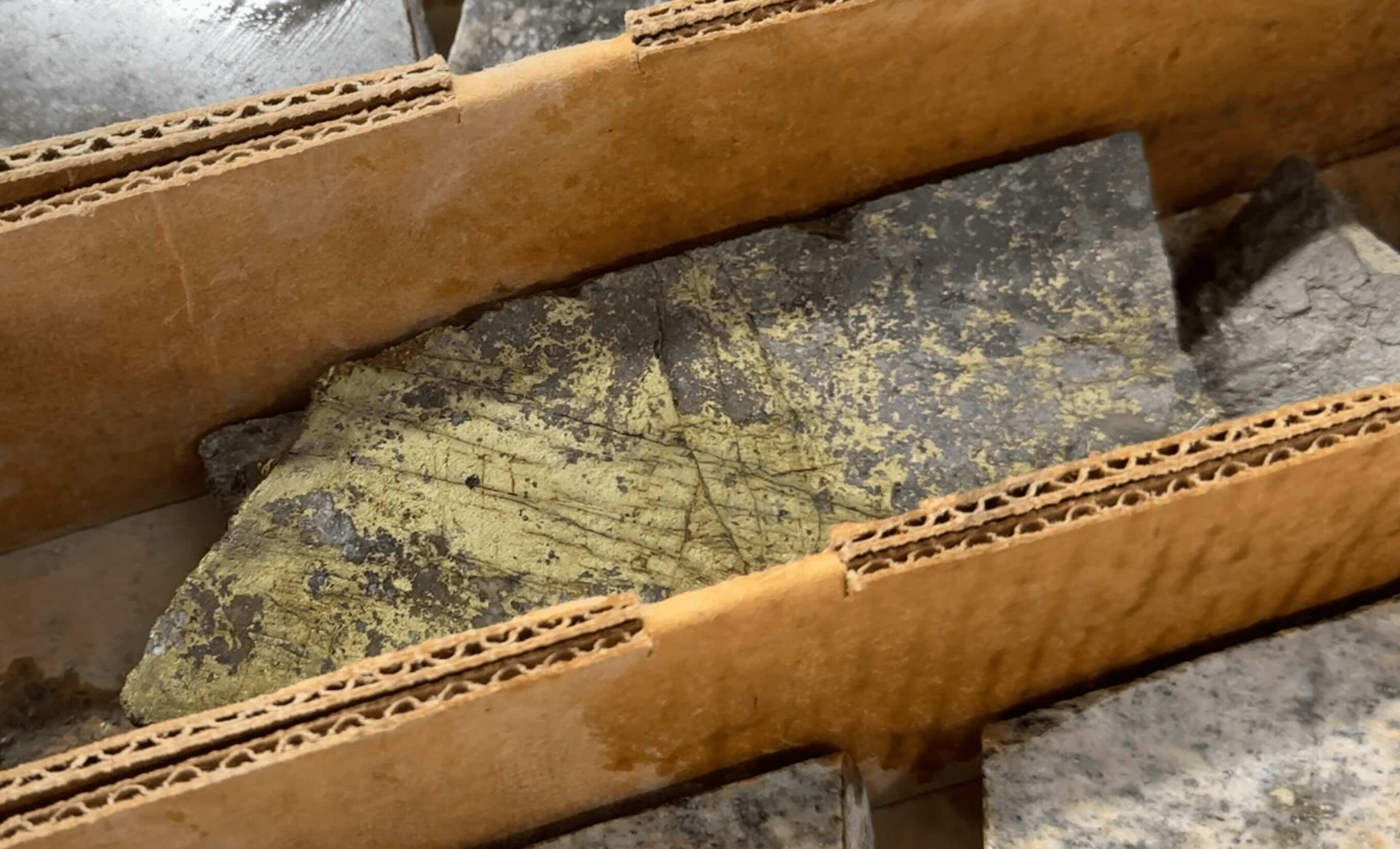
The upper portions of the deposit show some oxidation, which affects processing characteristics. "In terms of the whole deposit, it's a sulphide deposit but we see a little bit of oxidization at the very top," Bee notes. "Essentially we would say maybe 10% is subject to some oxidization, 10% a transition zone, and 80% is sulfide mineralization." In the oxide zones, some copper minerals won't respond to flotation, resulting in lower recoveries, but the overall economics remain robust.
Importantly, the project avoids controversial processing methods that often trigger community opposition. There's no heap leaching, no cyanide use, and no conventional tailings storage facility. Instead, the operation will produce filtered, dry-stack tailings that can be co-disposed with waste rock. This is a significant environmental and safety advantage.
The Path to Permitting: A Model for Community Engagement
Perhaps no achievement better demonstrates US Gold Corp's execution capability than successfully obtaining Wyoming's first hard rock mining permit in a century. This milestone, achieved with minimal public opposition, reflects a carefully orchestrated approach to community engagement and technical excellence in project design.
On-site with Government Affairs & Community Relations Consultant, Jason Beggar
Jason Beggar, the company's Wyoming-based Government Affairs and Community Relations consultant, describes the strategic approach from the project site:
"A really important part of this project is that community local buy-in, that social capital and license to operate. It was really important to meet with them often, regularly, early to understand their concerns, the things that we can do to make this thing work."
Understanding local stakeholder priorities proved crucial. "A lot of their concerns weren't necessarily with a mine itself," Beggar reveals. "It was water. If you're going to make a pit, what could that do to our water wells? And so the extensive hydrology that was done and drilling that was done to demonstrate that it's not going to impact them at all, people were honestly really okay with it."
The permitting process required five major permits: industrial siding, land quality, air quality, water quality, and county planning approval. Each involved public comment periods and open houses where community concerns could be addressed. Beggar reveals that through this extensive process, the team encountered minimal opposition:
"What we found is really minimal public opposition. And I wouldn't even say we had opposition. We had a couple of people raise some various concerns about various aspects, but they were more technical in nature. Like for example, what's going to happen to our water? What about dust or noise? Those are solvable engineering challenges, not any sort of physical or philosophical opposition to mining."
Wyoming's mining heritage played a significant role in community acceptance. "Wyoming is a natural resource state," Beggar explains. "The vast majority of tax revenue does come from coal mining, trona, oil and gas. So while hard rock mining is new or newer to this generation, it's been many decades since the state has had a hard rock mine. People are generally understanding of industry and those types of things. And they're just really demanding that it's done right and the right way."
Two critical technical decisions proved instrumental in securing community support. First, the project employs simple flotation processing with no heap leaching or cyanide use. Second, there will be no tailings dam. Instead, filtered dry-stack tailings will be co-disposed with waste rock. As Beggar emphasizes:
"You took the two biggest hot button issues that can rile up the NGOs and the general public to the point where people were like, well, this is just kind of a quarry with some backend processing. There's no smelter, so there's not going to be any stack emissions. It's a really simple, clean mining project."
Development Strategy & Economics
The CK Gold Project's development strategy reflects a disciplined approach to capital allocation and risk management. Rather than chasing ounces to expand the resource, management made a strategic decision to focus on permitting and economic optimization of a robust starter project.
Luke Norman explains the rationale:
"That reserve is constrained purely by the amount of drilling we were prepared to undertake at the time. We didn't want to actually expand too much resource, chasing ounces to depth and laterally when the next focus after we established a reserve was to actually get permits."
Standing at the proposed pit location, George Bee outlines the mining sequence: "Looking out you can see some of the green, that's a reclaimed drill site. The edge of the open pit would be probably just where that double track road is. And then over the hill down the valley over that way. So essentially this part of the deposit is poking up and will be mined down in three phases and then we establish a pit rim and go down about 700 foot. So probably the bottom of the pit is about a thousand foot below where we're standing now."
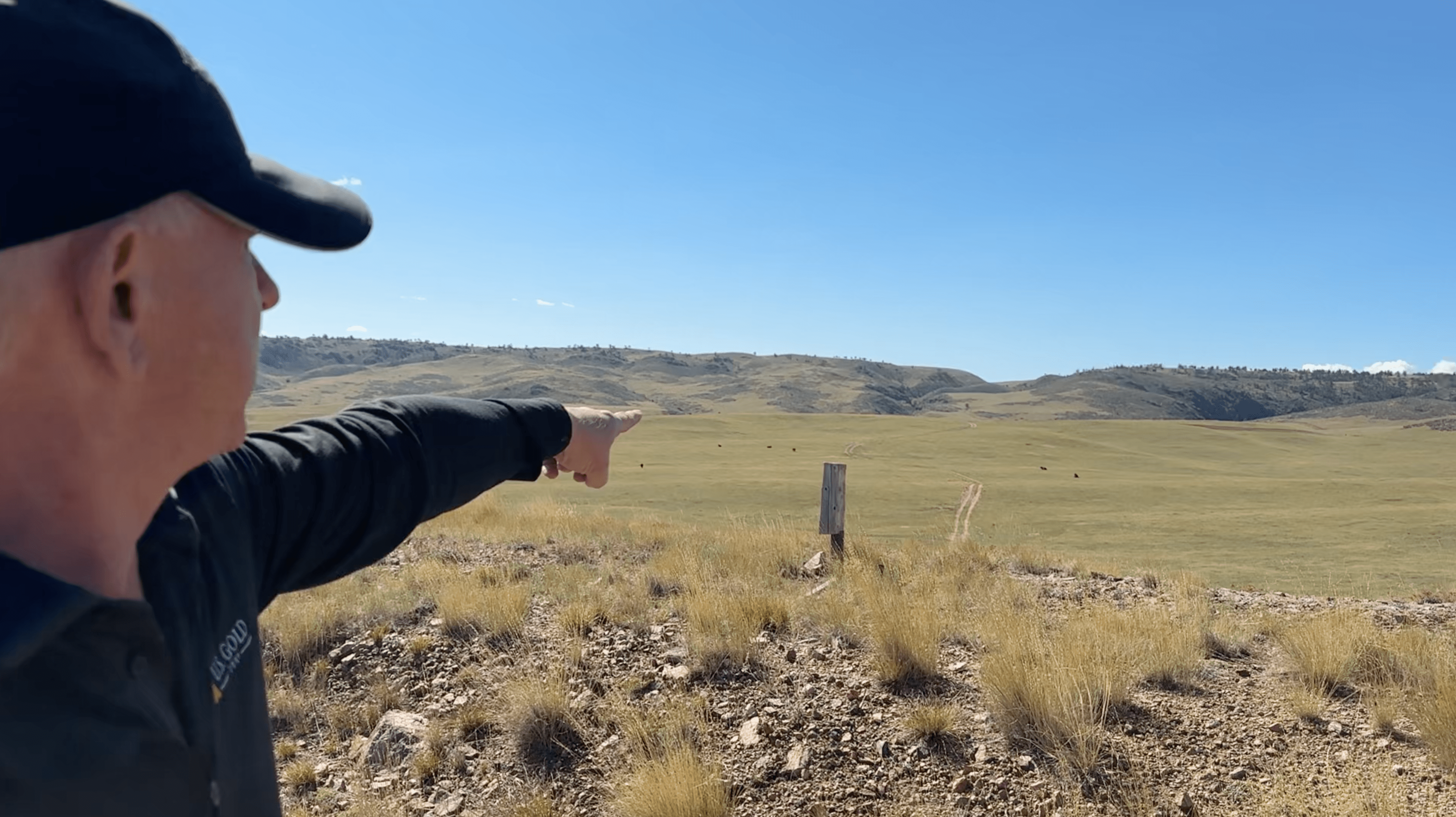
The strategic placement of infrastructure has been carefully planned to minimize environmental impact while maximizing operational efficiency. "Now looking there, we're essentially looking towards the area where the mill will be," Bee explains while pointing south. "You can see a single track road that leads towards the top of that ridge and just over the ridge, there's going to be the process plant just to the right of the picture. We're behind a height of land there which shelters the plant."
This sheltered location provides natural screening from prevailing winds and noise, while maintaining proximity to critical infrastructure. The Crystal Reservoir, visible from the pit area, will provide process water through an arrangement with the city of Cheyenne, a solution that benefits both the project and the local Curt Gowdy State Park.
Project Economics & Financial Metrics
This approach has yielded a project with compelling economics that improve dramatically in the current price environment. The current mine plan envisions a three-phase open pit operation extending approximately 700 feet below surface at its deepest point. With 1.7 million ounces of gold equivalent in reserves - specifically one million ounces of contained gold and 260 million pounds of copper - the operation targets 110,000 ounces of annual gold production over a 10-year mine life.
The pre-feasibility study published in February 2025 outlined an all-in sustaining cost of $940 per ounce using a baseline of $2,400 gold. Luke Norman emphasizes the dramatic improvement at current prices: "About an 80% gold economic, 20% copper economics right now, just because of course, the gold price has surged so high."
At current gold prices around the $4,000 per ounce mark, the project economics become even more compelling. George Bee provides specific metrics:
"At current gold prices, we've got, in terms of net present value, just shy of a billion dollars worth of gold and copper. It'll pay back in less than a year, which is exceptional." When pressed about the NPV at even higher gold prices, Bee clarifies: "It's a billion at $2,100. So at $4,000, it's significantly higher."
The company's disciplined approach extends to resource expansion. "We know that we bottom out in mineralization," Bee explains. "We didn't dilute our shareholders by just drilling it and making it larger for the sake of making it larger until we'd essentially proven up that it was going to make money and it was going to be permissible to mine." He adds confidently: "We expect the mine life at the moment is 10 years, it's going to be at least another five years."
Unlocking Additional Value: The Aggregate Opportunity
The company is exploring additional revenue opportunities that could significantly enhance project returns. The waste rock that must be moved to access the ore has substantial value as construction aggregate, a market US Gold Corp is uniquely positioned to serve.
"When you look at this rock, this is pretty barren, but it makes super aggregate and rail ballast," Bee notes while examining drill core samples. The opportunity is validated by nearby operations: Martin Marietta operates a large quarry just three miles south of the project, selling similar material for $20-25 per tonne.
Bee provides detailed economics on this opportunity:
"By trucks, we can potentially sell a million tonnes per year. So that's - at 20 bucks per tonne - that's $20 million value. We've already paid for the mining, so we need to do some crushing and screening. We would need to pay a royalty to the state, so $10 to $15 margin, so $10 to $15 million just on top of the copper and gold operation."
The potential expands significantly with rail access. "If we can get that rock onto a rail car your market expands dramatically. So double, triple that amount."
What makes this opportunity particularly attractive is its longevity. "The thing about the rock resource is it's going to go on for decades," Bee emphasizes.
"We've expended energy to get the rock out of the ground so that we can get at the copper and gold. I really like the idea of capitalizing on the fact that we spent that energy - we've produced the rock, now we can put it to beneficial use."
When asked about the NPV impact of aggregate sales, Bee acknowledges: "It's not a game changer, but it certainly adds value. After the mine life of 10-15 years, we've set all that rock aside, the rock mining has been paid for, that then becomes a long-term opportunity to serve the growth in the local market for construction, road base, etc."
Building the Team & Advancing to Construction
The assembly of an experienced development team underscores US Gold Corp's transition from explorer to near-term producer. The appointment of George Bee as CEO brought four decades of mine building experience, including leadership roles in constructing some of the world's largest gold mines.
Luke Norman provides context on Bee's credentials:
"What a veteran in terms of digging a hole and extracting gold. He cut his teeth building Goldstrike for Barrick. So you can imagine, that ultimately led to the Barrick we know today. He's built some of the largest gold mines on the planet."
Norman emphasizes the importance of this expertise: "When we decided to shift our focus over from exploration to development, you need somebody who's got the real seasoned developer because there was a lot of question marks around Wyoming."
The Wyoming-specific expertise proved equally crucial. Recognizing the importance of local relationships, the company brought on Jason Beggar as their in-state specialist early in the process.
The team has since expanded to include former Wyoming Governor Dave Freudenthal, who works directly with the company.
"We really wanted to establish a good foothold within the community so that people could understand exactly what we're going in to do there," Norman explains.
This local engagement strategy has proven invaluable in building community understanding of the project. Norman draws parallels to nearby operations to help stakeholders visualize the development: "Just to our south is a 40 billion dollar materials company, Martin Marietta, right on the I-80 highway there. It's the exact same mining method, essentially. They're going in, it's an open pit and they're harvesting granite diorite and just selling it as aggregate into the Colorado basin and out to California and the Western seaboard."
He emphasizes the similarities to reassure community members:
"Ours is not much different other than we crush ours and grind ours down a lot finer and we run it through a recovery plant to get those metals out. But there's no smoke stacks or any of that. So we needed the community to understand that it's not a heavily impactful type of mining. We're coming in, we're essentially establishing a quarry and we're moving materials off site to be smelted."
Financing Strategy & Market Interest
The elevated gold price environment has created favorable conditions for project financing, with US Gold Corp attracting interest from both traditional and non-traditional capital sources. The company's fully permitted status and near-term production timeline have proven particularly attractive to financiers seeking exposure to gold production rather than exploration risk.
"We've had a lot of interest, clearly, being one of the only projects that's fully permitted, ready to go," Norman reveals. "Even with the new administration in the US, permitting is still a purgatory, as I like to refer to it. In the US or in Canada, no matter where you want to go, it's very difficult. So having that permit in place has brought us a lot of attention."
The project's copper component has opened additional financing avenues. "The fact that we're going to be generating a copper-gold concentrate, because there is a lot of copper in this system, has led to a lot of interest from the trade," Norman notes, referring to potential strategic investors from the mining and metals trading sectors.
Concrete progress on financing is already evident. "There's been a term sheet presented to us from a debt component for building this project," Norman confirms. However, the company is taking a methodical approach to optimize terms:
"What we're doing right now is just really strengthening the whole economic case for the project, also securing some of the real hard line items such as putting in foundations for crushers."
The recently signed power agreement represents a significant de-risking milestone. "We just signed a power agreement very recently with Black Hills Energy securing 7.2 cents kilowatt hour," Norman announces. "And that's amortized with power right to the project. Let's take that into consideration - we're not running hundreds of kilometers of power to get to this project."
These concrete steps are attracting diverse funding sources. Norman notes:
"Those processes, those steps right now are leading to a lot of interest from financiers, not just traditional bankers but non-traditional sources of capital."
Construction Timeline & Key Milestones
The path from fully permitted project to producing mine follows a clear timeline with specific milestones that de-risk the development at each stage. The definitive feasibility study, expected in December 2025, represents the next major catalyst, incorporating recent optimization work and current metal price assumptions.
"We anticipate and we're aiming to be completing the investment decision by the end of this year and we want to be up in production in 2026," George Bee states, outlining the aggressive but achievable timeline. The company is already advancing critical path items, with Norman noting they're "securing some of the real hard line items such as putting in foundations for crushers."
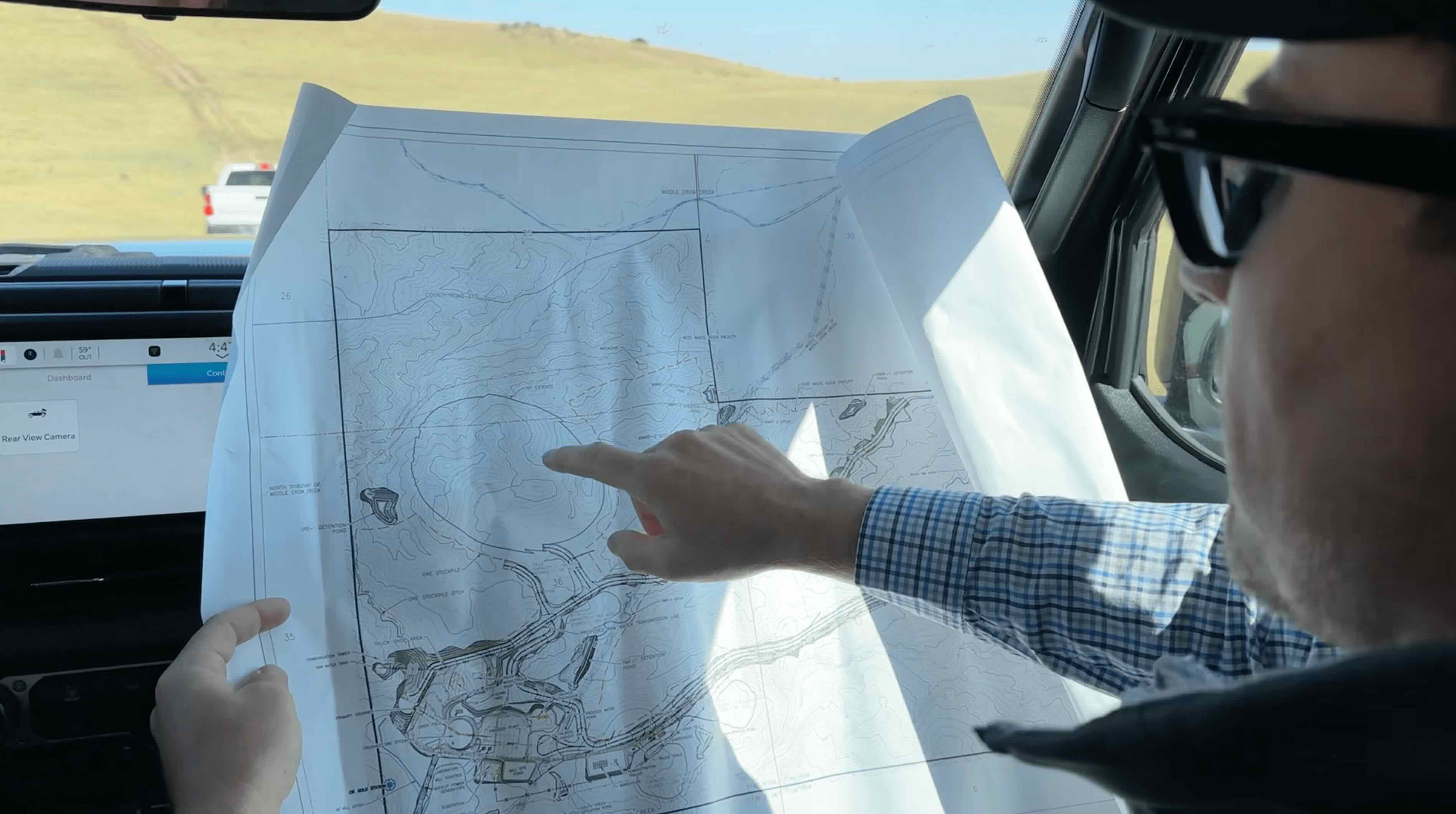
Ground breaking is scheduled for early 2026, with Luke Norman confirming: "We'll start breaking ground here in the earlier part of next year." The construction phase is expected to take approximately 18-24 months, positioning the project for first production by late 2028.
The company's proactive approach to securing long-lead items and critical infrastructure agreements accelerates the timeline. The recently signed power agreement with Black Hills Energy at 7.2 cents per kilowatt hour removes a significant uncertainty, while ongoing discussions with rail operators for aggregate transport could unlock additional value streams before gold production begins.
Community Integration & Workforce Development
The project's proximity to Cheyenne offers unique advantages for workforce development and community integration. Unlike remote projects requiring fly-in/fly-out operations or extensive camp facilities, CK Gold can draw from an established regional workforce.
"We have an entire resource hub community of prospective employees sitting there," Luke Norman emphasizes. "Anything from larger data centers to distribution outlet centers for the likes of Amazon are being built there currently. So just a huge workforce."
This local employment strategy benefits both the project and the community. Workers can maintain their homes and family lives in Cheyenne while commuting the short distance to site. Jason Beggar captures this advantage succinctly:
"We're only about 20 minutes from town. You can grab a cup of coffee, get out to the site, and coffee's still warm."
A Vision for Wyoming's Mining Future
Standing on the future pit rim with mountains visible in three directions and Cheyenne's growth spreading westward on the horizon, the CK Gold Project represents more than just another gold mine. It symbolizes Wyoming's potential to diversify its resource economy beyond coal and oil into metals critical for both traditional and emerging technologies.
"We're the first hard rock mine to be permitted in Wyoming in a hundred years," Luke Norman states with evident pride. "Not because of lack of trying, it's just the lack of deposits that exist there currently."
The project's success in achieving permits and community support provides a template for responsible resource development in the modern era. By prioritizing stakeholder engagement, employing best-in-class environmental practices, and leveraging existing infrastructure, US Gold Corp has demonstrated that mining development and community interests need not be in conflict.
Jason Beggar reflects on the broader significance:
"While hard rock mining is new or newer to this generation, it's been many decades since the state has had a hard rock mine. People are generally understanding of industry... And they're just really demanding that it's done right and the right way."
The economic impact extends beyond direct employment and taxes. The project will purchase water from Cheyenne, supporting the Curt Gowdy State Park system. The aggregate sales will provide materials for regional infrastructure development. The economic multiplier effects will ripple through the regional economy for decades.
As Wyoming's first hard rock mine in a century moves toward production, it carries the potential to catalyze renewed interest in the state's mineral endowment while providing a new source of employment and tax revenue for local communities. With gold prices at historic highs and copper demand growing from electrification trends, the timing for CK Gold's development appears optimal.
George Bee summarizes the opportunity:
"We know that we've got resources at depth. It's going to get bigger. The mine life at the moment is 10 years, it's going to be at least another five years. But then after that, we've set all that rock aside, the rock mining has been paid for, that then becomes a long-term opportunity to serve the growth in the local market."
Aerial View of the CK Gold Project, with CEO George Bee
Investment Thesis for US Gold Corp
US Gold Corp presents a compelling investment opportunity as one of the few fully permitted, construction-ready gold projects in North America. The company's CK Gold Project in Wyoming offers multiple investment catalysts:
- Near-term production visibility with construction beginning in early 2026 and first gold possible by late 2028, providing investors with a clear path to cash flow generation in a rising gold price environment. The project's sub-one-year payback period at current metal prices significantly de-risks the investment case.
- Exceptional project economics driven by unique infrastructure advantages, with power, rail, workforce, and water all readily accessible, eliminating the massive capital requirements typical of remote mining projects. The $940/oz all-in sustaining cost positions CK Gold in the industry's lowest quartile.
- Eliminated permitting risk as Wyoming's first hard rock mine permit in 100 years is already secured, removing the primary development risk that delays or defeats most North American mining projects. This positions US Gold Corp years ahead of peers stuck in permitting purgatory.
- Multiple expansion opportunities with the current 10-year mine life based on conservative drilling, leaving significant resource expansion potential at depth and laterally. The aggregate sales opportunity could add $10-15 million in annual free cash flow.
- Experienced leadership with CEO George Bee's track record of building world-class mines providing technical credibility and execution confidence. Management's disciplined approach to development, focusing on permitting before resource expansion, demonstrates capital allocation prudence.
- Favorable financing environment with gold at historic highs attracting both debt and equity capital to near-term producers. The company's advanced permitting status and robust economics position it favorably for project financing negotiations.
- Strategic optionality through potential copper by-product credits becoming increasingly valuable as electrification drives demand, with copper representing 20% of project economics providing natural hedge diversification.
At current valuations, US Gold Corp trades at a significant discount to its net asset value, offering investors exposure to a de-risked development story with near-term production potential in a tier-one jurisdiction.
Macro Thematic Analysis
US Gold Corp's CK Gold Project development occurs at a pivotal intersection of multiple macro trends reshaping the North American mining landscape. The project exemplifies the critical importance of domestic resource production as geopolitical tensions drive Western nations to secure supply chains independent of authoritarian regimes. With gold reaching historic highs above $4,000 per ounce, driven by central bank buying, currency debasement concerns, and geopolitical uncertainty, the timing for new production capacity is optimal.
The Wyoming project also highlights the infrastructure advantage that will increasingly separate winners from losers in the mining sector. As environmental permitting becomes more stringent and social license more difficult to obtain, projects with existing infrastructure access and community support will command premium valuations. The decade-long permitting timeline that hampers most North American projects makes US Gold Corp's fully permitted status exceptionally valuable in an industry starved of production growth.
Furthermore, the project's copper component positions it within the electrification megatrend, as copper demand from electric vehicles, renewable energy, and grid expansion creates structural supply deficits. The ability to produce both precious and base metals from a single operation provides natural portfolio diversification while capitalizing on multiple commodity cycles. As institutional investors increasingly focus on ESG metrics and responsible mining practices, CK Gold's simple processing design without cyanide or tailings dams, combined with its brownfield location in a historic mining district, presents an attractive investment narrative.
The convergence of these factors - elevated metal prices, domestic production imperative, infrastructure accessibility, and responsible development practices - positions US Gold Corp to capitalize on a generational opportunity in North American resource development.
TL;DR:
US Gold Corp is developing Wyoming's first hard rock mine in 100 years, with full permits secured and construction beginning early 2026. Located just 20 miles from Cheyenne with exceptional infrastructure access, the CK Gold Project targets 110,000 ounces annual gold production at $940/oz all-in costs over 10 years. The simple flotation process requires no cyanide or tailings dam, earning strong community support. Led by veteran mine-builder George Bee, the company has secured competitive power rates and is advancing financing discussions. With robust economics showing sub-one-year payback at current gold prices plus potential aggregate sales adding $10-15 million annually, US Gold Corp offers rare near-term production visibility in a tier-one jurisdiction. The project's strategic advantages position it as one of North America's most attractive gold development opportunities.
FAQ's (AI Generated)
Analyst's Notes




Subscribe to Our Channel
Stay Informed











































